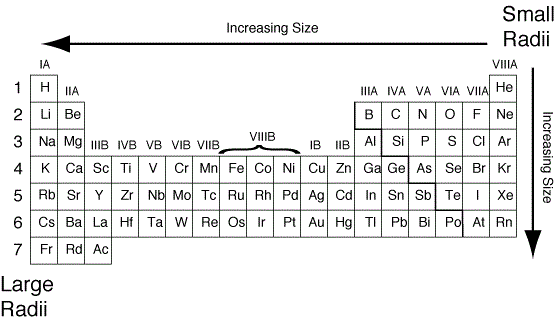

Between 90000 people are believed to have died from the bomb in the four-month period following the explosion. As you move from left to right across an element period row the ionic radius decreases.Ītomic size decreases as you move across a rowor periodof the table because the increased number of protons exerts a stronger pull on the electrons. Even though the size of the atomic nucleus increases with larger atomic numbers moving across a period the ionic and atomic radius decreases. The first atomic radius periodic trend is that atomic size decreases as you move left to right across a period.Ītomic size decreases from. When an electron is added a new proton is also added to the nucleus which gives the nucleus a. The figures used to construct this diagram are based on. As you go down a group the atomic radius increases.

Covalent radii for Si P S and Cl.Ītomic symbols including mass number atomic number and charge Information 4 He a helium nucleus also known as an alpha particle an electron also known as a beta particle when emitted by a nucleus Model The following are two nuclear reaction equations. Within a period of elements each new electron is added to the same shell. Electronegativity in the period table increases as you move from left to right across a period and decreases as you move from top to bottom in a group. Trends In The Periodic Table Chpt 7 1 Atomic Radius Size 2 Ionization Energy 3 Electronegativity The Ionization Energy Periodic Table Covalent Bonding Conversion example for the atomic radius of sodium 186 pm 186 10-12 m 0186 10-9 m 0186 nm 186 pm 186 10-12 m 186 10-10 6 If you would like a more detailed explanation of the changes in first ionisation energy across the period go to the Ionisation Energy and Electronic Configuration tutorial. This is due to the shielding affect where electrons in lower energy levels shield the positive charge of the nucleus from outer electrons resulting in those outer electrons not being as tightly bound to the atom.In one time period become maximum minimum two time So It means frequency of is 2. Elements near the bottom of the chart have so many electrons that losing or acquiring an electron is not as big a deal. They have a stronger desire to acquire more electrons. Why? Elements near the top of the period table have few electrons to begin with every electron is a big deal. Group - electronegativity decreases as you go down a group. Elements on the right side of the period table only need a few electrons to complete the octet, so they have strong desire to grab another atom's electrons. As a result, they have low electronegativity. Why? Elements on the left of the period table have 1 -2 valence electrons and would rather give those few valence electrons away (to achieve the octet in a lower energy level) than grab another atom's electrons. Period- electronegativity increases as you go from left to right across a period. Why? The shielding affect makes it easier to remove the outer most electrons from those atoms that have many electrons (those near the bottom of the chart).Įlectronegativity is an atom's 'desire' to grab another atom's electrons Group - ionization energy decreases as you go down a group. Elements on the left of the chart would prefer to give up their electrons so it is easy to remove them, requiring less energy (low ionization energy). The means it will require more energy to remove the outer most electron. Why? Elements on the right of the chart want to take others atom's electron (not given them up) because they are close to achieving the octet. Period - ionization energy increases as you go from left to right across a period.

It is closely related to electronegativity Ionization energy is the amount of energy required to remove the outmost electron. Additionally, new energy levels of elections clouds are added to the atom as you move from period to period down a group, making the each atom significantly more massive, both is mass and volume.

Why? There is a significant jump in the size of the nucleus (protons + neutrons) each time you move from period to period down a group. Group - atomic radius increases as you go down a group. Why? Stronger attractive forces in atoms (as you go from left to right) between the opposite charges in the nucleus and electron cloud cause the atom to be 'sucked' together a little tighter. Period - atomic radius decreases as you go from left to right across a period. Summary of Periodic Table Trends Atomic Radius


 0 kommentar(er)
0 kommentar(er)
